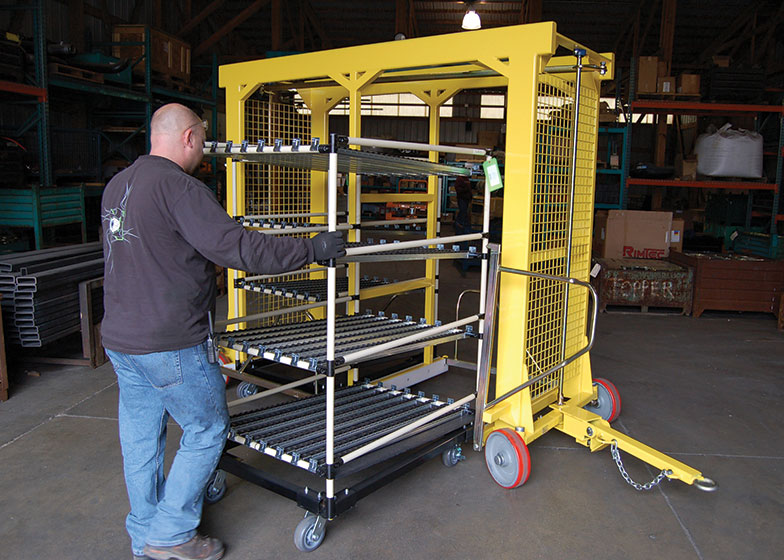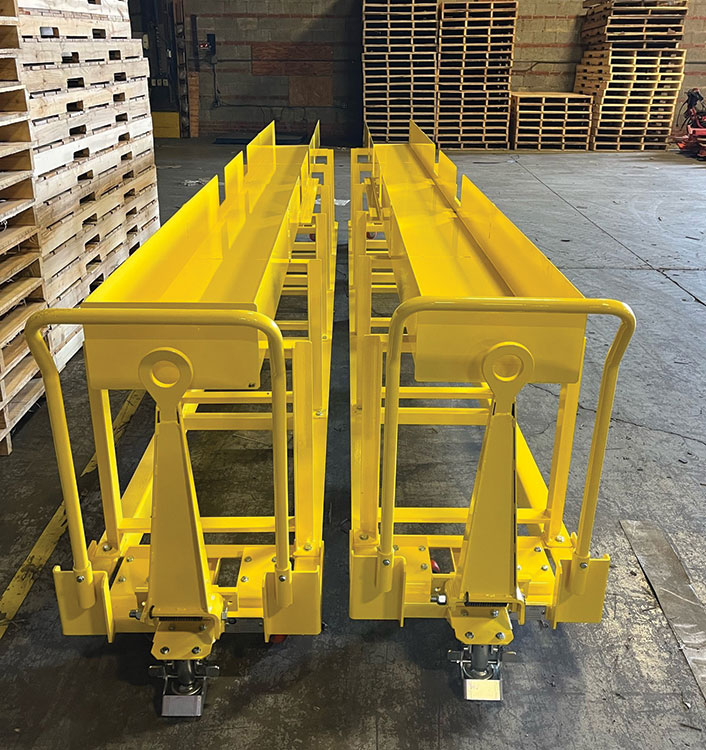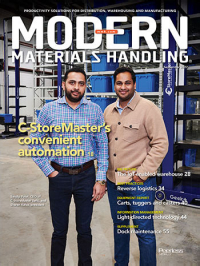Carts, tuggers, and casters: Keep the warehouse wheels turning
In today’s warehouses and DCs, companies want efficient, reliable equipment that can be operated safely. Here’s how makers of carts, tuggers and casters are responding to those needs.

Carts, tuggers and casters are playing an increasingly important role in today’s busy warehouses and DCs, where managing ongoing labor shortages, supply chain constraints and an uptick in e-commerce order volumes requires careful orchestration on the floor. There, order-picking carts move items from one location to the next; tuggers tow connected “trains” of non-powered carts around the facility; and casters enable easier maneuvering of racks, carts and other equipment.
Together, this trio of warehouse mainstays supports the movement of goods, inventory and other items in a fulfillment center or other operation. Similar to most other materials handling equipment, carts and tuggers are incorporating more automation and autonomous capabilities. Automatic guided vehicles (AGVs), for example, travel autonomously throughout a facility without the need for an onboard driver or operator.
“Manpower is a big issue that companies are struggling with right now. They just don’t have the people in place to be able to do all of the work,” says B.G. Edwards, vice president of sales and marketing at Creform Corp. “Many of them are looking to replace their existing manual cart delivery systems—and other functions that operators have to handle manually—with automated options.”
Answering the call
Responding to customer requests, Edwards says Creform has worked on several new implementations that incorporate automated processes into existing setups. For example, it recently automated a customer’s existing, manual kitting carts.
Now, instead of loading up carts in the “offline” position, the company simply loads up AGVs that, in turn, deliver the goods to the mainline for further processing.
Edwards says companies are also asking for more turnkey solutions that include design, fabrication, assembly, testing and installation. They also need more consultative support, which Creform readily provides.
“Companies want us to come in and identify where we can supply automated solutions, and that’s a bit of a change from the past,” says Edwards. “Most of the time with these projects, customers pretty much have a defined scope. Today, they’re also looking for new ideas and help finding some non-traditional-type methods to solve their problems.”
One of those problems is a lack of available space in the warehouse or DC, where every foot of horizontal and vertical space is valuable. To help its customers deal with space constraints, Creform has been minimizing the physical footprints of its units. At the other end of the spectrum, some customers are asking for larger units—a trend that’s pushed the company to start making 15- to 20-foot-long AGVs (versus the more standard 10-foot models).

Creform is also adding side-to-side movement capabilities to its products, knowing that in some cases a cart may need to fit into a tight area—and particularly if the company is trying to consolidate storage space.
“Ultimately, everyone is looking for low-maintenance, reliable cart solutions,” says Edwards, “that are both efficient and safe to operate.”
Going back to basics
Before the pandemic hit, Topper Industrial was fielding a lot of requests for carts that could be pulled by AGVs. And while demand for automated options has remained steady over the last 2.5 years, more companies are interested in a product that the company developed years ago and that “really didn’t take off” at the time, according to Ed Brown, president.
He’s seeing increased demand for the company’s Mother Daughter Cart Systems, which are pulled either by an AGV or a tugger. The system comprises a large mother frame cart and two or more smaller daughter delivery carts, the latter of which fit within the former’s framework. With the daughter carts locked inside, the full assembly can be tugged as one component or towed in a row.
“These have become ultra-popular for Topper,” says Brown, who adds that eight out of 10 of the firm’s sizable orders of $1 million or more now involve Mother Daughter Cart Systems.
One key may be the fact that these carts don’t have to be decoupled. Instead, the smaller carts are simply pulled into the larger “mother” cart. The carts are generally suitable for facilities where aisle space is ample enough to accommodate them.
Like many other manufacturers, Topper is dealing with supply constraints for the raw materials and components that go into its products. “There was a time when I first started this company when a customer would go elsewhere if you had a 6- to 7-week backlog,” Brown recalls. “That’s quadrupled now.” He tells companies that are shopping for carts, tuggers and casters this year to factor that time into their plans and also recommends taking the time to match the right product to the specific application.
Doing so not only ensures a good fit, but it also keeps companies from overspending where it may not be necessary. “Take the time to ensure that the entire product was designed to do what you want it to do,” says Brown, “right down to the individual casters.”
Divide by three, not four
At Hamilton Caster & Mfg. Co., vice president of marketing Mark Lippert is seeing greater demand for the company’s AGV line of casters and wheels. This makes sense, he says, seeing that more companies are deploying more automation in their facilities as a way to offset the impacts of the ongoing labor shortage. Lippert says more companies are also asking for sophisticated options like the manufacturer’s high-heat and stainless steel casters.
“These are not your run-of-the-mill, high-volume operations where someone needs new casters for a toolbox,” Lippert points out. “They may have an autoclave or industrial sized oven that’s heated to 750 degrees and in need of casters that can withstand the harsh environment.”
Hamilton’s Inferno casters come in light-, medium- and the MagmaMax heavy-duty series and can accommodate anywhere from 150 pounds to 9,000 pounds, depending on the specific product.
Hamilton has recently gotten into heavy-duty industrial press-on tires, which are forklift tires that are “pressed” onto machined cores that the manufacturer machines in-house. Developed for heavy manufacturing industries, the tires are most often used on gantry cranes, large construction equipment and in aerospace applications. The manufacturer also recently introduced a line of UltraGlide casters and wheels. They feature easier rolling and swiveling for ergonomic applications and require less energy, which translates into longer AGV life.
Lippert says the new products reduce the amount of energy needed to move loads in manual or powered applications and feature independent swivel surfaces that eliminate scrubbing, which makes it easier to turn. “We’re making these products in-house, and we’re pretty excited about it,” says Lippert, who advises companies to research their options thoroughly before selecting and buying casters for their specific environments.
“There’s more to casters than most people realize, so pick up the phone and talk to an expert before you make your selection,” says Lippert. “Know the application, the carrying capacity and the environment that the casters will be used in, and he or she should be able to make a pretty quick, expert recommendation on which caster or wheel will work best.”
When calculating the number of casters for a specific load or capacity, Lippert says it’s best to divide the total load capacity by three versus four. “People don’t always account for uneven loads or floor surfaces (i.e., when traveling over concrete expansion joints),” he explains. “At those points, the load may only be distributed across three of the casters, so it’s always best to divide it by three when calculating load capacity.”
Making jobs easier
Right now, Kevin Kuhn, president of Kinetic Technologies, is seeing a lot of pent-up demand due to the pandemic and the impacts that it’s had on the labor market, supply chain disruption and other constraints. He’s fielding requests for large solutions down to very small orders, and hasn’t seen any negative impacts of inflation or the potential for a downturn interfering with business yet.
“From our perspective, it’s been a good, solid market,” says Kuhn. “At this point, however, it’s hard to read the tea leaves.”
This year, Kinetic has been focused on developing customized solutions for customers, with a focus on AGVs, robotics and ergonomics. A maker of industrial carts, cart lifts and conveyor systems designed for lean material flow systems, the company has introduced a number of new products over the last year in response to customer demand. In most cases, those innovations focus on facilitating the decanting process and improving ergonomics.
“We look at what can be done from a materials handling standpoint to make production and materials handling jobs palatable in today’s working environment,” says Kuhn. “That includes automation, with a focus on making things a little bit easier for anyone working in the plant or on the warehouse floor.”
Anyone investing in carts right now should work with a provider that “plays in the space every day,” says Kuhn, and realize that there may be more to the product than meets the eye. “Carts seem simple, but they can be complex—to a certain point—when they’re done right.”

Article Topics
Tuggers News & Resources
Tuggers, carts & casters work in harmony to fill the labor gap Carts, tuggers, and casters: Keep the warehouse wheels turning Mini Case History: Smarter materials transport in the four walls Guardian Industries transforms continuous improvement Tuggers, carts and casters: Evolving the wheel for automation Raymond partners with K.Hartwell to introduce solutions, including tow-train system Quick Start to Facility Efficiency with AMRs More TuggersLatest in Materials Handling
Registration open for Pack Expo International 2024 Walmart chooses Swisslog AS/RS and software for third milk processing facility NetLogistik partners with Vuzix subsidiary Moviynt to offer mobility solutions for warehouses Materials Handling Robotics: The new world of heterogeneous robotic integration BSLBATT is looking for new distributors and resellers worldwide Lucas Watson appointed CSO for Körber’s Parcel Logistics business in North America Hyster recognizes Dealers of Distinction for 2023 More Materials HandlingAbout the Author
Subscribe to Materials Handling Magazine

Find out what the world's most innovative companies are doing to improve productivity in their plants and distribution centers.
Start your FREE subscription today.
April 2024 Modern Materials Handling

Latest Resources











